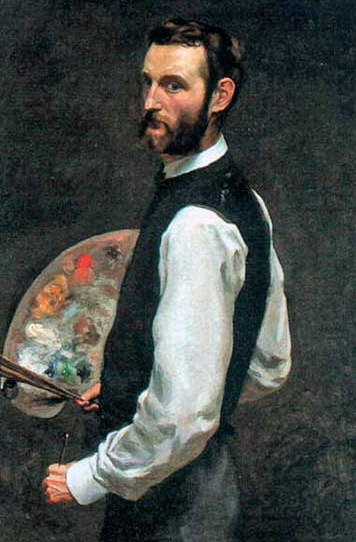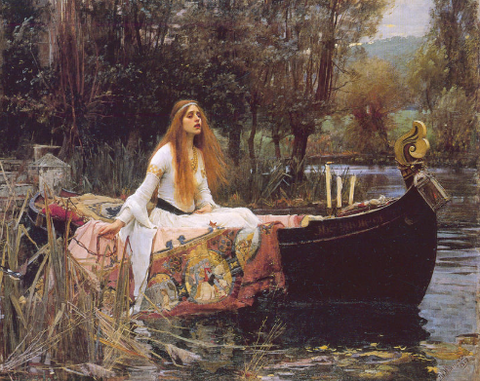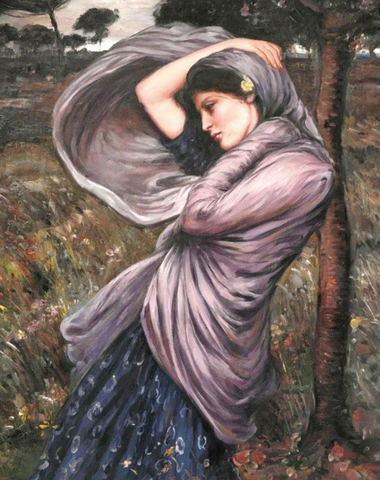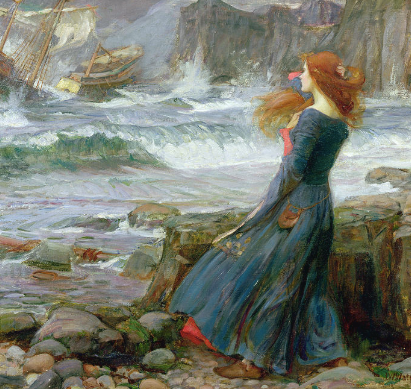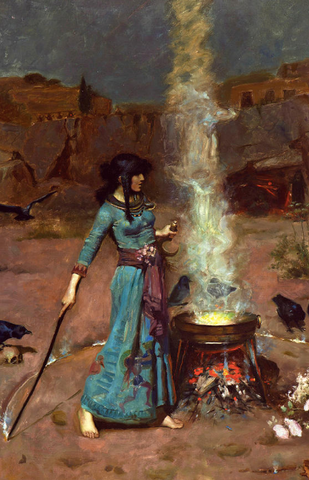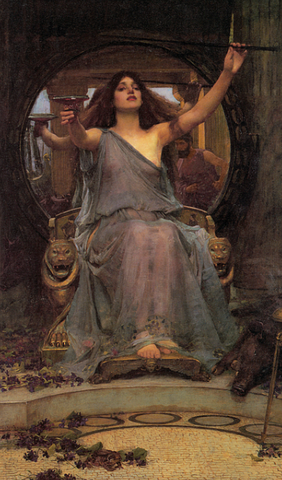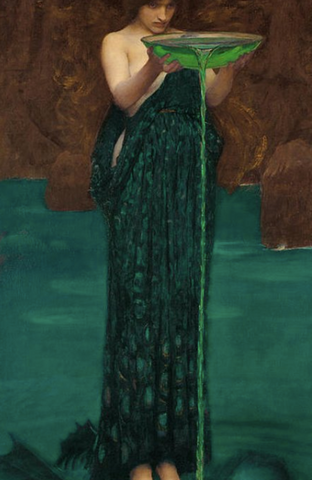Top 10 Most Famous Paintings by John William Waterhouse
Who is John William Waterhouse?
John William Waterhouse was an English painter known for his Academic style paintings and Pre-Raphaelite Brotherhood art. Waterhouse is commonly known for portraying women in his art using old Greek folklore and Arthurian legend stories.
Waterhouse's initial works were not all Pre-Raphaelite in nature they where very similar to Alma-Tadema and Frederic Leighton.
John William Waterhouse Famous Artworks:
- The Lady of Shalott by John William Waterhouse
- Hylas and the Nymphs by John William Waterhouse
- Boreas by John William Waterhouse
- Miranda - The Tempest by John William Waterhouse
- The Soul of the Rose by John William Waterhouse
- The Magic Circle by John William Waterhouse
- Circe Offering the Cup to Ulysses by John William Waterhouse
- Circe Invidiosa by John William Waterhouse
- A Mermaid by John William Waterhouse
- Echo and Narcissus by John William Waterhouse
The Lady of Shalott by John William Waterhouse
Waterhouse has painted three variants of this composition, first in 1888, then in 1894 and lastly in 1915. It is one of his most renowned works, done in the Pre-Raphaelite Brotherhood style.
One of the The Lady of Shalott paintings was given to the general public by Sir Henry Tate in 1894 and can be viewed at the Tate Britain in London.
The painting depicts the main character of Tennyson's poem, titled: The Lady of Shalott (1842). In the poem, the Lady Shalott had been bound to her quarters on an island near the city of Camelot. She was cursed to stay in the tower and look at the outside world through a mirror reflection.
The painting reveals the third part of the poem, where Sir Launcelot is seen by Sharlott and the sound of him singing takes her away from the tower and breaks her curse and she gets on a boat to go to the city of Camelot.
Artist: John William Waterhouse
Year: 1888
Medium: Oil on canvas
Dimensions: 183 cm × 230 cm (72 in × 91 in)
Location: Tate Britain, London
Leonardo Da Vinci Most Famous Paintings
Hylas and the Nymphs by John William Waterhouse
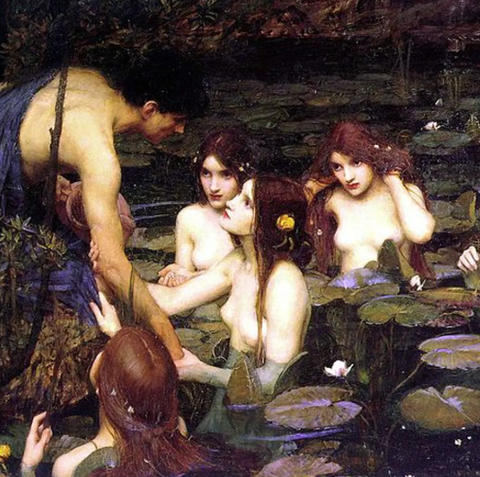
The work of art depicts a moment from a Greek/Roman legend: the unfortunate story of Hylas; in which a youthful Hylas is snatched by naiads (female water nymphs) while looking for drinking water.
Hylas was the child of King Theiodamas of the Dryopians. After Hercules executed Hylas's father; Hylas became an Argonaut going with Jason to look for the Golden Fleece. During the voyage, Hylas was sent to discover freshwater. He found a lake with Naiads.
The painting portrays Hylas, wearing a blue tunic and holding onto a wide-necked water container. The naiads are naked and are depicted with radiant skin; they have yellow and white blossoms in their reddish-brown hair. They all seem to have very similar body types. One of the naiads is holding Hylas's wrist and elbow, and a second one is pulling at his tunic, and a third holds out pearls in the palm of her hands.
The scene is delineated in a first point of view position, looking down at the water, just like Hylas. Hylas's position in the composition gives insight to the observer on how Hylas was in the moment when he first meet the Naiads.
Artist: John William Waterhouse
Year: 1896
Medium: Oil on canvas
Dimensions: 98.2 by 163.3 centimeters (38.7 in × 64.3 in)
Location: Manchester Art Gallery
Michelangelo Most Famous Paintings
Boreas by John William Waterhouse
This striking portrait is of a young woman standing in the blowing wind; as her scarf is being blown away by the wind, she holds on to it. The setting seems to be set during the spring time with pink blooms and yellow daffodils in the background of the painting.
For over 90 years, this composition was lost until it reappeared again around 1990 where it was available for purchase. This captivating work is named after Boreas, the Greek lord of the northern wind.
Artist: John William Waterhouse
Year: 1903
Medium: Oil on canvas
Location: Private collection
Dante Gabriel Rossetti Most Famous Paintings
Miranda - The Tempest by John William Waterhouse
Miranda is a fictional character in one of the later works of William Shakespeare's play, The Tempest. Waterhouse painted this composition in 1916, it's one of his most famous works of art and portrays Miranda as described in one of the most prevalent scenes of the play. Miranda looks onward to sea and sees a ship get split in two by the massive ground-breaking waves.
Artist: John William Waterhouse
Year: 1916
Medium: Oil on canvas
Dimensions: 110.4×137.8 cm
Location: Private collection
Francois Boucher Most Famous Paintings
The Soul of the Rose by John William Waterhouse
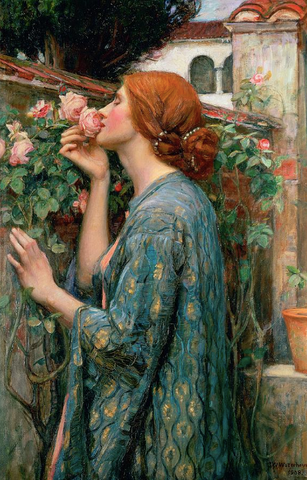
This is one of the few paintings that Waterhouse painted not depicting an ancient tale. Instead, it shows a woman in a garden, this woman is believed to be the woman that Alfred Lord Tennyson wrote of in a poem. The poem talks about a woman who in her garden is thinking about a past lover.
Below is a piece of the poem.
'Come into the Garde, Maud' by Alfred Lord Tennyson
Come into the garden, Maud,
For the black bat, Night, has flown,
Come into the garden, Maud,
I am here at the gate alone;
And the woodbine spices are wafted abroad,
And the musk of the roses blown.
For a breeze of morning moves,
And the planet of Love is on high,
Beginning to faint in the light that she loves
On a bed of daffodil sky,
To faint in the light of the sun she loves,
To faint in his light, and to die.
All night have the roses heard
The flute, violin, bassoon;
All night has the casement jessamine stirr'd
To the dancers dancing in tune
Till a silence fell with the waking bird,
And a hush with the setting moon.
I said to the lily, "There is but one
With whom she has heart to be gay.
When will the dancers leave her alone?
She is weary of dance and play. "
Now half to the setting moon are gone,
And half to the rising day;
Low on the sand and loud on the stone
The last wheel echoes away.
I said to the rose, "The brief night goes
In babble and revel and wine.
O young lordlover, what sighs are those
For one that will never be thine?
But mine, but mine," so I sware to the rose,
"For ever and ever, mine. "
And the soul of the rose went into my blood,
As the music clash'd in the hall;
And long by the garden lake I stood,
For I heard your rivulet fall
From the lake to the meadow and on to the wood,
Our wood, that is dearer than all;
From the meadow your walks have left so sweet
That whenever a March-wind sighs
He sets the jewelprint of your feet
In violets blue as your eyes,
To the woody hollows in which we meet
And the valleys of Paradise.
The slender acacia would not shake
One long milk-bloom on the tree;
The white lake-blossom fell into the lake,
As the pimpernel dozed on the lea;
But the rose was awake all night for your sake,
Knowing your promise to me;
The lilies and roses were all awake,
They sigh'd for the dawn and thee.
Queen rose of the rosebud garden of girls,
Come hither, the dances are done,
In gloss of satin and glimmer of pearls,
Queen lily and rose in one;
Shine out, little head, sunning over with curls,
To the flowers, and be their sun.
There has fallen a splendid tear
From the passion-flower at the gate.
She is coming, my dove, my dear;
She is coming, my life, my fate;
The red rose cries, "She is near, she is near;"
And the white rose weeps, "She is late;"
The larkspur listens, "I hear, I hear;"
And the lily whispers, "I wait. "
She is coming, my own, my sweet;
Were it ever so airy a tread,
My heart would hear her and beat,
Were it earth in an earthy bed;
My dust would hear her and beat,
Had I lain for a century dead;
Would start and tremble under her feet,
And blossom in purple and red.
Artist: John William Waterhouse
Year: 1908
Medium: Oil on canvas
Dimensions: 34¾ x 23¼ in. (88.3 x 59.1 cm.)
Location: Private collection
John Everett Millais Most Famous Paintings
The Magic Circle by John William Waterhouse
The woman in this image gives off an impression of being a witch or priestess who is enriched with magic powers and appears to be making some sort of potion. Her haircut resembles that of an early Anglo-Saxon; her dress looks Persian or Greek. In her left hand she holds a sickle. In her right hand she has a long wand and appears to be drawing a circle for an enchantment.
Artist: John William Waterhouse
Year: 1866
Medium: Oil on canvas
Dimensions: 6′ 0″ x 4′ 2″
Location: Tate Britain, Private collection
Giorgione Most Famous Paintings
Circe Offering the Cup to Ulysses by John William Waterhouse
Waterhouse was motivated by Homer's Odyssey when he painted this work. Circe was a beautiful and charming sorceress who transformed humans into animal creatures by giving them a magical wine to drink. Circe utilized magic on Ulysses' men and transformed them into pigs while Ulysses (Odysseus) wasn't around. Ulysses knowing of her magic received protection from Hermes to avert Circe's magic. When he went to Circe, and she had him drink the wine mixture to transform him into a pig too. It didn't work and Ulysses drew his sword on Circe who in fear asked him to have mercy.
Artist: John William Waterhouse
Year: 1891
Medium: Oil on canvas
Dimensions: 175 cm × 92 cm (69 in × 36 in)
Location: Gallery Oldham, Oldham
Top 10 Most Famous Paintings by Wassily Kandinsky
Circe Invidiosa by John William Waterhouse
The painting portrays a tall woman with her head slightly tilted down; she is pouring a green fluid from a bowl into the blue-green water beneath her. At her feet there appears to be a shadowy figure swimming in the water.
In Greek mythology, Circe was a goddess/sorceress who had knowledge of mixing various herbs to create magical enchantments. This painting depicts the story of Circe pouring a greenish substance into the water with the intention of changing her adversary Scylla into a beast.
Artist: John William Waterhouse
Year: 1892
Medium: Oil on canvas
Dimensions: 179 cm × 85 cm (70 in × 33 in)
Location: Art Gallery of South Australia, Adelaide
Top 10 Most Famous Paintings by Thomas Sully
A Mermaid by John William Waterhouse

The mermaid sits alone near land brushing her long reddish hair. Next to her is a huge shell with pearls. She appears to be singing a melody. Mermaids customarily baited mariners to their demise using their charming tunes.
Artist: John William Waterhouse
Year: 1900
Medium: Oil on canvas
Dimensions: 3′ 3″ x 2′ 2″
Location: Royal Academy of Arts
Top 10 Most Famous Paintings by Sandro Botticelli
Echo and Narcissus by John William Waterhouse

This painting delineates a scene from 'Reverberation and Narcissus' from the Roman poet Ovid's Metamorphosis.
Artist: John William Waterhouse
Year: 1903
Medium: Oil on canvas
Dimensions: 109.2 cm × 189.2 cm (43 in × 74 in)
Location: Walker Art Gallery, Liverpool
Top 10 Most Famous Paintings by Georgia O'Keeffe
John William Waterhouse Paintings
Exploring the Depths of John William Waterhouse's Mythological Themes
Dive into the mythological themes that permeate John William Waterhouse's body of work, revealing the artist's fascination with ancient legends and stories. This exploration uncovers how Waterhouse's paintings, such as "Ulysses and the Sirens" and "The Siren," bring to life the enchanting and often tragic tales from Greek mythology, Arthurian legend, and beyond.
By blending realistic portrayal with mythological storytelling, Waterhouse invites viewers into a world where the boundaries between reality and legend blur, highlighting his unique contribution to the Pre-Raphaelite movement.
The Enigmatic Women of John William Waterhouse's Paintings
Unravel the mystery behind the enigmatic women who grace John William Waterhouse's paintings. Characters like the beguiling "Lady of Shalott" and the doomed "Ophelia" are central to Waterhouse's work, embodying both beauty and tragedy.
This discussion delves into the artist's portrayal of women, not just as subjects of aesthetic admiration but as complex figures ensnared in their destinies. Waterhouse's ability to capture the emotional depth and inner turmoil of his female subjects has cemented his legacy as a painter who deeply empathizes with his characters, offering viewers a glimpse into the souls of these iconic figures.
John William Waterhouse's Contribution to the Pre-Raphaelite Movement
Examine John William Waterhouse's significant contribution to the Pre-Raphaelite movement, highlighting his unique position as a bridge between the original Brotherhood and its later followers. Despite coming into prominence years after the movement's inception, Waterhouse embraced and extended the Pre-Raphaelite principles of detailed naturalism, medieval themes, and complex compositions.
His work, characterized by its vivid storytelling and rich, sensuous detail, played a crucial role in the enduring popularity and evolution of Pre-Raphaelite art, making him a pivotal figure in this artistic lineage.
The Lyrical Beauty of Nature in Waterhouse's Work
Celebrate the lyrical beauty of nature as captured in the canvases of John William Waterhouse. From the tranquil waters in "The Lady of Shalott" to the lush, verdant backgrounds of "Nymphs Finding the Head of Orpheus," nature plays a starring role in Waterhouse's art.
This segment explores how the artist uses natural settings not just as backdrops but as integral components of his narratives, imbuing his scenes with a sense of place and atmosphere. Waterhouse's attention to the natural world's detail and beauty underscores his paintings' romantic and sometimes melancholic mood, drawing viewers into a harmonious relationship with the environment.
The Mastery of Emotion and Atmosphere in Waterhouse's Paintings
Delve into John William Waterhouse's mastery of emotion and atmosphere, which sets his paintings apart as evocative works of art. Whether portraying the intense longing of "Echo and Narcissus" or the tragic isolation of "The Lady of Shalott," Waterhouse skillfully uses color, light, and composition to evoke strong feelings and create a palpable atmosphere.
This analysis highlights how Waterhouse's art transcends mere representation, offering instead a window into the emotional landscapes of his subjects and inviting viewers to experience the depth of their stories firsthand.
Check out these Famous Artists who have shaped the art world!
If you like this article, please share it with others, so perhaps they can also enjoy it and get value from it. Any of the artwork purchased on ATX Fine Arts accommodates me as an artist/ writer along with helping the site grow organically, thank you.

